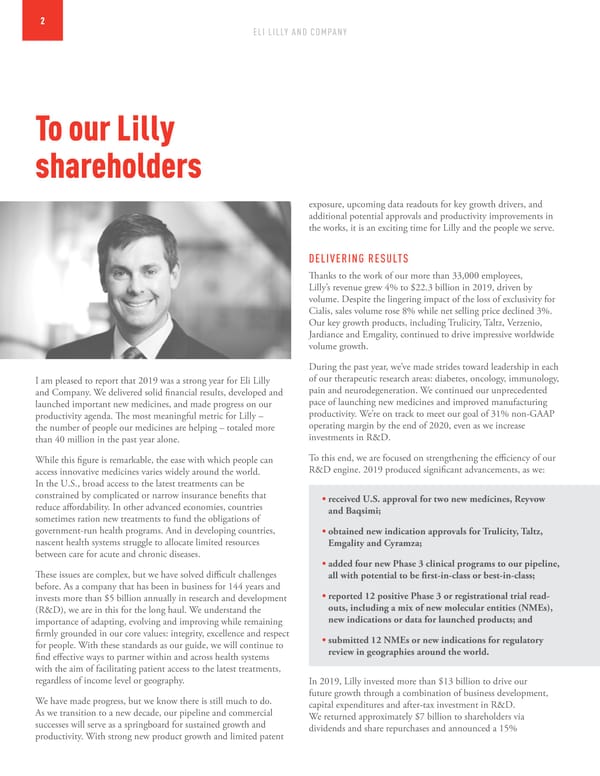2 ELI LILLY AND COMPANY To our Lilly shareholders exposure, upcoming data readouts for key growth drivers, and additional potential approvals and productivity improvements in the works, it is an exciting time for Lilly and the people we serve. DELIVERING RESULTS Thanks to the work of our more than 33,000 employees, Lilly’s revenue grew 4% to $22.3 billion in 2019, driven by volume. Despite the lingering impact of the loss of exclusivity for Cialis, sales volume rose 8% while net selling price declined 3%. Our key growth products, including Trulicity, Taltz, Verzenio, Jardiance and Emgality, continued to drive impressive worldwide volume growth. During the past year, we’ve made strides toward leadership in each I am pleased to report that 2019 was a strong year for Eli Lilly of our therapeutic research areas: diabetes, oncology, immunology, and Company. We delivered solid financial results, developed and pain and neurodegeneration. We continued our unprecedented launched important new medicines, and made progress on our pace of launching new medicines and improved manufacturing productivity agenda. The most meaningful metric for Lilly – productivity. We’re on track to meet our goal of 31% non-GAAP the number of people our medicines are helping – totaled more operating margin by the end of 2020, even as we increase than 40 million in the past year alone. investments in R&D. While this figure is remarkable, the ease with which people can To this end, we are focused on strengthening the efficiency of our access innovative medicines varies widely around the world. R&D engine. 2019 produced significant advancements, as we: In the U.S., broad access to the latest treatments can be constrained by complicated or narrow insurance benefits that • received U.S. approval for two new medicines, Reyvow reduce affordability. In other advanced economies, countries and Baqsimi; sometimes ration new treatments to fund the obligations of government-run health programs. And in developing countries, • obtained new indication approvals for Trulicity, Taltz, nascent health systems struggle to allocate limited resources Emgality and Cyramza; between care for acute and chronic diseases. • added four new Phase 3 clinical programs to our pipeline, These issues are complex, but we have solved difficult challenges all with potential to be first-in-class or best-in-class; before. As a company that has been in business for 144 years and invests more than $5 billion annually in research and development • reported 12 positive Phase 3 or registrational trial read- (R&D), we are in this for the long haul. We understand the outs, including a mix of new molecular entities (NMEs), importance of adapting, evolving and improving while remaining new indications or data for launched products; and firmly grounded in our core values: integrity, excellence and respect • submitted 12 NMEs or new indications for regulatory for people. With these standards as our guide, we will continue to review in geographies around the world. find effective ways to partner within and across health systems with the aim of facilitating patient access to the latest treatments, regardless of income level or geography. In 2019, Lilly invested more than $13 billion to drive our We have made progress, but we know there is still much to do. future growth through a combination of business development, As we transition to a new decade, our pipeline and commercial capital expenditures and after-tax investment in R&D. successes will serve as a springboard for sustained growth and We returned approximately $7 billion to shareholders via productivity. With strong new product growth and limited patent dividends and share repurchases and announced a 15%
 Integrated Summary Report Page 2 Page 4
Integrated Summary Report Page 2 Page 4